第七章 思维
- 格式:ppt
- 大小:82.50 KB
- 文档页数:17
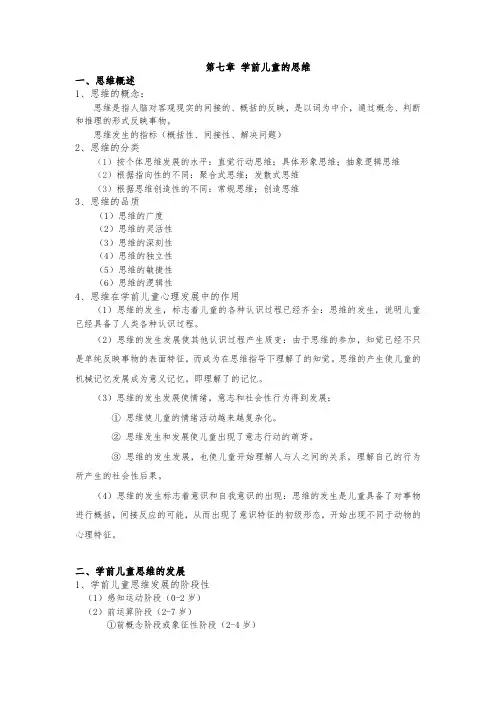
第七章学前儿童的思维一、思维概述1、思维的概念:思维是指人脑对客观现实的间接的、概括的反映,是以词为中介,通过概念、判断和推理的形式反映事物。
思维发生的指标(概括性、间接性、解决问题)2、思维的分类(1)按个体思维发展的水平:直觉行动思维;具体形象思维;抽象逻辑思维(2)根据指向性的不同:聚合式思维;发散式思维(3)根据思维创造性的不同:常规思维;创造思维3、思维的品质(1)思维的广度(2)思维的灵活性(3)思维的深刻性(4)思维的独立性(5)思维的敏捷性(6)思维的逻辑性4、思维在学前儿童心理发展中的作用(1)思维的发生,标志着儿童的各种认识过程已经齐全:思维的发生,说明儿童已经具备了人类各种认识过程。
(2)思维的发生发展使其他认识过程产生质变:由于思维的参加,知觉已经不只是单纯反映事物的表面特征,而成为在思维指导下理解了的知觉。
思维的产生使儿童的机械记忆发展成为意义记忆,即理解了的记忆。
(3)思维的发生发展使情绪,意志和社会性行为得到发展:①思维使儿童的情绪活动越来越复杂化。
②思维发生和发展使儿童出现了意志行动的萌芽。
③思维的发生发展,也使儿童开始理解人与人之间的关系,理解自己的行为所产生的社会性后果。
(4)思维的发生标志着意识和自我意识的出现:思维的发生是儿童具备了对事物进行概括,间接反应的可能,从而出现了意识特征的初级形态,开始出现不同于动物的心理特征。
二、学前儿童思维的发展1、学前儿童思维发展的阶段性(1)感知运动阶段(0-2岁)(2)前运算阶段(2-7岁)①前概念阶段或象征性阶段(2-4岁)这一阶段的主要特点是思维开始运用象征性符号进行。
出现表征功能,或称象征性功能。
前概念阶段,儿童思维中的物体已经减少个别性,带有某些一般性,概括性。
前概念思维的特点,还表现在认为个别成分并不是在整体中。
前概念思维是“中心化”的思维,或称“自我中心思维”。
②直觉思维阶段(4-7岁)直觉思维阶段是前概念思维向运算思维过渡的中间阶段。
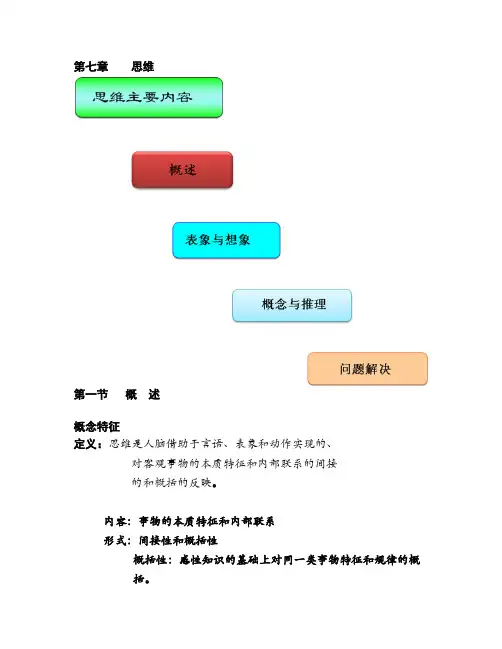
第七章思维第一节概述概念特征定义:思维是人脑借助于言语、表象和动作实现的、对客观事物的本质特征和内部联系的间接的和概括的反映。
内容:事物的本质特征和内部联系形式:间接性和概括性概括性:感性知识的基础上对同一类事物特征和规律的概括。
间接性:感性知识基础上对客观事物的间接认识时空性:不受时空的限制加工水平:更高级的信息加工活动,是探索和发现新物的心理过程。
思维过程分析和综合分析:把事物整体分解为部分、把复杂事物分解为简单要素分别加以考虑的智力操作综合:把事物的各个部分、各个方面、各种因素联系起来加以考虑的智力操作比较:确定对象之间的差异点与共同点的智力操作抽象和概括抽象:把事物的共同属性、本质特征抽取出来,并把它们与其它属性、次要特征分离的智力操作。
概括:把抽象出来的事物的共同属性、本质特征联系起来的智力操作。
思维种类◆按性质◆直观动作思维:(又称实践思维),面临的思维任务具有直观的形式。
解决问题的方式依赖于实际的动作。
(3岁前)◆具体形象思维:指利用头脑中的具体形象来解决问题(学前期)。
◆语词逻辑思维;人们面临理论性质的任务,并要运用抽象的概念、理论知识来解决问题的思维。
是人类思维的典型形式◆按创造性◆再生性思维(常规思维):只要重现过去类似情景中已学会的方法便能使问题得到解决。
◆创造性思维:要求提出新的、发明性的办法来解决问题的思维◆按思维形式➢辐合性思维:(又叫聚合式思维,集中思维)把问题所提出的各种信息加以重新组织,从而得出一个正确答案或最佳解决方案的思维。
➢发散思维:(又叫分散性思维,辐射思维)是一种沿着不同的方向去思考,追求多样性的思维。
◆根据凭借物➢经验思维:借助日常生活经验进行的思维活动➢理论思维:根据科学的概念和论断,判断某个事物,解决某个问题。
◆按遵循逻辑➢形式逻辑思维:有明确的逻辑形式的思维。
又叫分析思维。
➢非形式逻辑思维:没有一定的逻辑形式,不遵循一定的逻辑规则的思维。
例如直觉思维➢经验思维:借助日常生活经验进行的思维活动➢理论思维:根据科学的概念和论断,判断某个事物,解决某个问题。
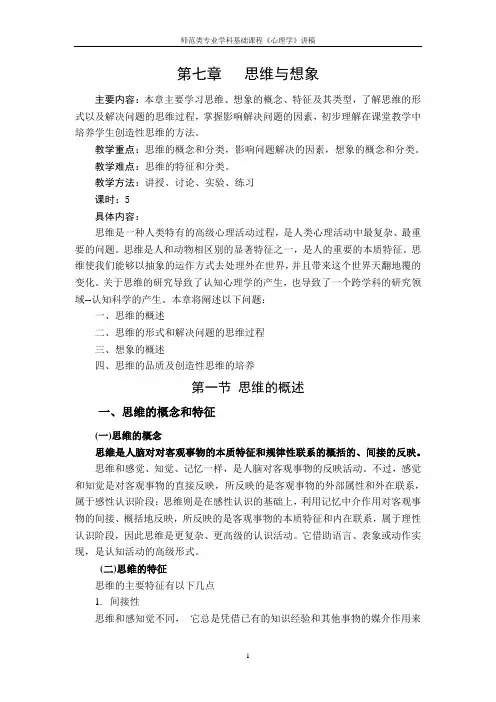
第七章思维与想象主要内容:本章主要学习思维、想象的概念、特征及其类型,了解思维的形式以及解决问题的思维过程,掌握影响解决问题的因素,初步理解在课堂教学中培养学生创造性思维的方法。
教学重点:思维的概念和分类,影响问题解决的因素,想象的概念和分类。
教学难点:思维的特征和分类。
教学方法:讲授、讨论、实验、练习课时:5具体内容:思维是一种人类特有的高级心理活动过程,是人类心理活动中最复杂、最重要的问题。
思维是人和动物相区别的显著特征之一,是人的重要的本质特征。
思维使我们能够以抽象的运作方式去处理外在世界,并且带来这个世界天翻地覆的变化。
关于思维的研究导致了认知心理学的产生,也导致了一个跨学科的研究领域--认知科学的产生。
本章将阐述以下问题:一、思维的概述二、思维的形式和解决问题的思维过程三、想象的概述四、思维的品质及创造性思维的培养第一节思维的概述一、思维的概念和特征(一)思维的概念思维是人脑对对客观事物的本质特征和规律性联系的概括的、间接的反映。
思维和感觉、知觉、记忆一样,是人脑对客观事物的反映活动。
不过,感觉和知觉是对客观事物的直接反映,所反映的是客观事物的外部属性和外在联系,属于感性认识阶段;思维则是在感性认识的基础上,利用记忆中介作用对客观事物的间接、概括地反映,所反映的是客观事物的本质特征和内在联系,属于理性认识阶段,因此思维是更复杂、更高级的认识活动。
它借助语言、表象或动作实现,是认知活动的高级形式。
(二)思维的特征思维的主要特征有以下几点1.间接性思维和感知觉不同,它总是凭借已有的知识经验和其他事物的媒介作用来对客观事物作出非直接的反映,因此,具有间接性。
例如,闻到饭菜香味,推断妈妈在厨房、根据手边的各种资料推测火星上的状况。
正是由于思维的间接性,人们才可能超越了感知觉提供的信息,认识那些没有直接作用于人的感官的事物的属性,从而揭示事物的本质和规律,实现对未来的预测。
2.概括性在大量的感性材料的基础上,把一类事物的共同特征和规律抽离出来加以认识,这就是思维的概括性。
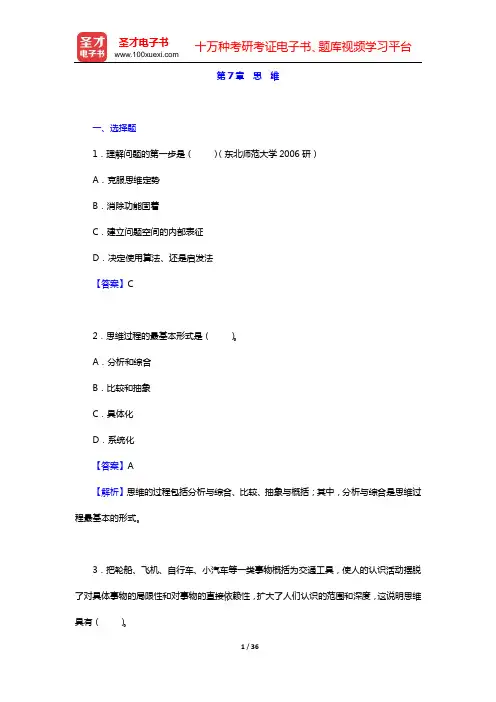
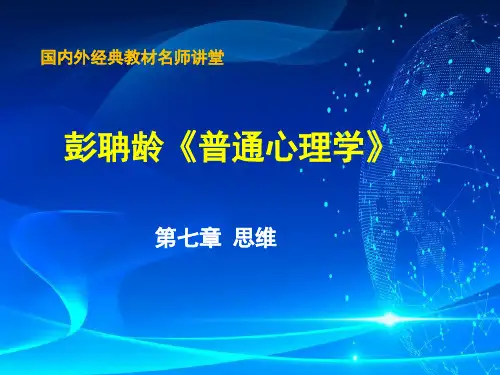
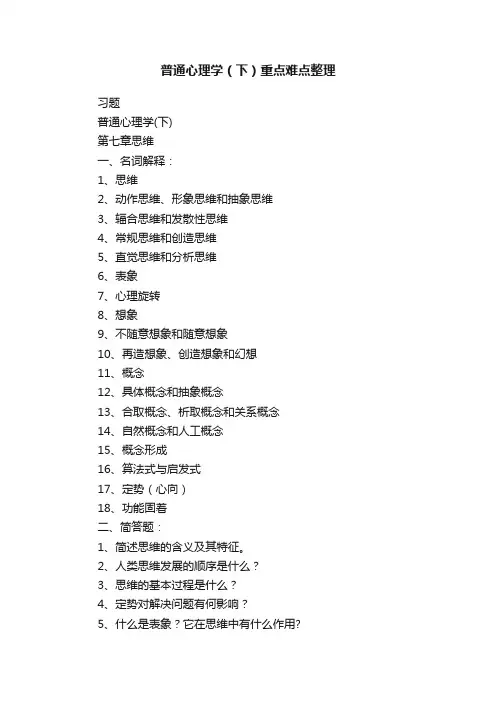
普通心理学(下)重点难点整理习题普通心理学(下)第七章思维一、名词解释:1、思维2、动作思维、形象思维和抽象思维3、辐合思维和发散性思维4、常规思维和创造思维5、直觉思维和分析思维6、表象7、心理旋转8、想象9、不随意想象和随意想象10、再造想象、创造想象和幻想11、概念12、具体概念和抽象概念13、合取概念、析取概念和关系概念14、自然概念和人工概念15、概念形成16、算法式与启发式17、定势(心向)18、功能固着二、简答题:1、简述思维的含义及其特征。
2、人类思维发展的顺序是什么?3、思维的基本过程是什么?4、定势对解决问题有何影响?5、什么是表象?它在思维中有什么作用?6、简述想象的含义及其功能。
7、为什么说思维是一种高级的认知活动?8、试术问题解决过程中常采用的策略。
9、什么是有意想象?它有哪些种类和特点?三、论述题1、什么是问题的解决?、试分析日常生活中,有哪些心理因素影响着问题的解决?2、综合分析人在推理过程中发生错误的可能原因。
3、如何培养大学生的创造性思维4、试论述认知心理学关于概念结构的理论和发展。
5、有关概念结构的理论有哪些?简述这些理论的主要观点。
6、简要评价概念形成的两种理论。
7、为什么人们在推理过程中,总会出现一些推理错误?8、问题解决过程中可采用哪些策略?11、什么是创造性?它有什么特征,以及包括哪些心理成分?第八章语言一、名词解释:1、语言理解2、布洛卡区(Broca’s area)3、内部语言4、独白语言与对话语言5、语言的表征6、语言的加工7、威尔尼克区(Wernick’ area)9、语言知觉10、句子理解11、图式二、简答题1、语言与言语的区别与联系是什么?2、简述语言的表征和加工过程。
3、简述图式及其作用。
4、什么是语句的表层和深层结构?两者之间的关系怎样?5、简述语言的特点并利用这些特点评价心理学家教育黑猩猩学习语言的情况。
6、简述关于语言获得的两种对立的理论。




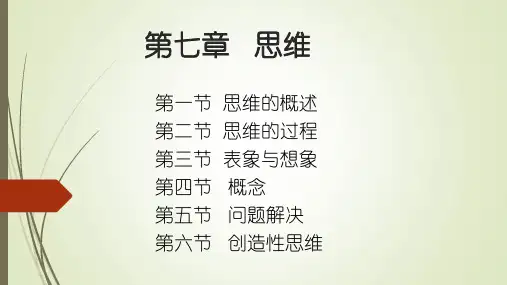
第七章思维第一节思维的一般概念一、思维的概念及特征(一)思维:指人脑借助于言语、表象和动作实现的、对客观事物的概括和间接的反映。
它揭露事物的本质特征和内部联系,是认识的高级形式,它主要表现在人们解决问题的活动中。
(二)思维的特征1、间接性思维活动不反映直接作用于感觉器官的事物,而是借助一定的媒介和一定的知识经验对客观事物进行间接的反映,这是思维的间接性。
如:早晨看屋顶潮湿,推知前一天晚上下雨;人们不能直接感知猿人的生活情景,但是考古学家通过化石可以思考古老的过去,复现出猿人的形象和当时的生活情景。
由于思维的间接性,人们才可能超越感知觉提供的信息,认识那些没有直接作用于人的各种事物属性,揭露事物的本质、规律,预见事物发展、变化的进程。
从这个意义上讲,思维认识的领域要比感知觉认识的领域更广阔、更深刻。
2、概括性思维是在大量感性材料的基础上,把一类事物的共同的本质的特征和规律抽取出来,加以概括,这就是思维的概括性。
如:人们把植物中具有繁殖功能的部位叫种子;把两个氢一个氧原子的化合物叫做水;种子有不同的形态和颜色,水也有不同的形态,人的思维不反映他们的具体形态,而是反映他们的共同特征。
概括在人们的思维活动中有着重要作用,它使人们的认识活动摆脱了具体事物的局限性和对事物的局限性和对事物的直接依赖关系,这不仅扩大了人们的认知的范围,也加深了人们对事物的了解。
所以概括水平在一定程度上表现了思维的水平。
另外,概括是人们形成概念的前提,也是思维活动能迅速进行迁移的基础。
3、思维是对经验的改组思维是一种探索和发现新事物的心理过程。
它的活动常常指向事物的新特征和新关系,这就需要人们对头脑已有的知识经验不断地更新和改组。
如:人们过去认为认识世界的最小物质是原子,后来发现原子还可以分裂为质子、中子、电子等。
概括这些新的发现,旧有的知识经验要重建、改组、更新。
人们的思维活动常常是由一定的问题情景引起的,并企图解决这些问题的过程,也是对头脑中已有的知识经验进行重新改组的过程。
第七章-思维一、单选题1.根据在解决问题时,思维活动的方向和思维的成果的特点,可将思维分为( )。
A.动作思维和形象思维B.辐合思维和发散思维C.常规思维和创造性思维D.形象思维和抽象思维2.人脑所形成的事物的映像与它所反映的事物木身之间的区别是 ( )。
A.前者是第一性的,后者是第二性的B.两者皆是第一性的,只不过是事物的映像以观念的形式存在C.前者是第二性的,后者是第一性的D.两者皆是第一性的,而被反映的客观事物是独立存在于现实中的实在的客体3.概念形成的策略中,( )是更有效的策略。
A.保守性聚焦B.冒险性聚焦C.同时性扫描D.继时性扫描4.在下述推理中,正确的是 ( )。
A.所有A都是B,所有C都是B,因而所有A都是CB.所有A都不是B,所有B都是C,因此所有A都不是CC.所有A都是B,所有B都是C,因而所有A都是CD.有些A是B,有些B是C,因此,有些A是C5.看完《西游记》后,脑中产生一个 "椰棚如生"的孙悟空的形象的心理过程是( )。
A.再造想象B.创造想象C.幻想D.表象形成6.思维是借助语言、表象或动作实现的,对客观事物 ( )的认识。
A.直接具体B.常规抽象C.概括间接D.直接概括7.为研究概念的形成,人们在实验室条件下对 ( )进行了研究。
A.具体概念B.抽象概念C.自然概念D.人工概念8.在解决河内塔问题时人们采用的策略是 ( )。
A.算法B.手段一目的分析C.逆向搜索D.爬山法9.在概念的层次网络模型中,每个概念结点上贮存的是 ( )。
A.该概念的独有特征B.本级概念共有的特征C.该概念的功能性特征D.该概念的所有特征10.心理旋转实验证明表象具有 ( )。
A.直观性B.稳定性C.概括性D.可操作性11、想象是人脑对已有的()进行加工改造而创造新形象的过程。
A经验B知识C客体D表象12、从爱听童话神话故事发展到爱听英雄模范故事,这是想象()发展的表现。
Chapter 7 Thinking, Language and Intelligence第七章思维,语言和智力This chapter includes three modules: first, module 21 discusses the process of thinking, and its role in problem solving and decision making; second, module 22 introduces two systems in our body: the nervous system and the endocrine system; last, we can learn our brain in module 7.MODULE 21 THINKINGThe first part of this chapter discusses the process of thinking, and its role in problem solving and decision making. Thinking is a cognitive process in which the brain uses information from the senses, emotions, and memory to create and manipulate mental representation, such as concepts, images, schemas, and scripts. Thus, in addition to the retrieval and processing of information from memory, cognition requires the manipulation of information in various ways.Mental images are Representations in the mind that resemble the object or event being represented. Using images and manipulating them help us think about and solve problems. Images also give us the power of visualization.ConceptsA concept is a mental category for classifying objects, people, and experiences based on their common features. Concepts help us think more efficiently about things and to categorize new experiences. Some concepts are "fuzzy," lacking clear-cut boundaries. Therefore, we often use prototypes, mental models of the most typical examples of a concept, to classify new objects. George Lakoff has extended the prototype model by observing that most of our concepts fit together to form idealized cognitive models (ICMs), which are our theories of events as we typically expect to find them.PROBLEM SOLVINGIn addition to thinking about things, human cognition involves the active use of language, images, and concepts—the building blocks of thought—to solve problems and make decisions.The Interpretation of ProblemsProblem representation, defining or interpreting the problem, is the first step in problem solving. We must decide whether to view the problem verbally, mathematically, or visually and how to categorize the problem. Expertise in a field increases a person's ability to interpret a particular problem.Producing and Evaluating SolutionsSelection of an optimum strategy for solving a problem follows problem interpretation.An algorithm is a prescribed method of problem solving that guarantees a correct solution if the method suits the problem and if it is carried out properly. Solving a mathematical problem by use of a formula is an example of the use of an algorithm.Heuristics are rules of thumb that help to simplify and solve problems, though they do not guarantee a correct solution. Means-end analysis, a heuristic that combines hill climbing and subgoals, aims to reduce the discrepancy between the current situation and the desired goal at a number of intermediate points. It allows us to take digressions or temporary steps backward that may be essential to solving the problem. There also are searching for analogies,breaking a big problem into small problems and Insight.Obstacles to Solving ProblemsEffective problem solving is tied to many factors, including the right level of motivation or emotional arousal. Too little emotion does not motivate, and too much may hinder the process of solution. Another factor that can help or hinder problem solving is Mental set, the tendency to perceive and to approach problems in certain ways. Sets enable us to draw on past experience to solve a present problem, but a strong set can also interfere with ability to use new and different approaches to solving a problem. One set that can seriously hamper problem solving is functional fixedness, the tendency to perceive only a limited number of uses for an object.CreativityCreativity is the combining of responses or ideas in novel ways.There are two factors associate with creativity: convergent thinking and divergent thinking. Convergent thinking is appropriate for problems that have just one correct solution, whereas problems that have no single correct solution call for creativity—divergent thinking, thinking that is original, inventive, and flexible.MODULE 22 LANGUAGELanguage is a flexible system of symbols used for communication. Spoken language is based on phonemes, the basic sounds that make up a language. Phonemes group together to form morphemes, the smallest meaningful units of speech, such as simple words, prefixes, and suffixes. When we wish to communicate an idea, we start with a thought, then choose words and phrases that will express the idea, and produce the speech sounds of those words and phrases. To understand speech, the task is reversed. Sentences have both a surface structure (particular words and phrases) and a deep structure (the underlying meaning).The rules that determine the meaning and form of words and sentences are called grammar. Semantics and syntax are the two major components of grammar. Semantics refers to how we assign meaning to the morphemes we use. Syntax is the system of rules for the structure of word forms and sentences.Critical period is a child is particularly sensitive to language cues and most easily acquires language. Great difficulty to overcome if not exposed to language during this critical period.Language acquisitionLearning-theory approachThe theory suggesting that language acquisition follows the principles of reinforcement and conditioning. However, it is less successful in explaining how child acquire language rules.Language-acquisition deviceA neural system of the brain hypothesized to permit understanding of language. Chomsky did not identify a specific area of the brain in which it resides.Language and thinkingThere are two opinions about language and thinking: Language produces thought and Thought produces language.The hypothesis of language produces thought suggests that language shapes may determine the way people in a particular culture perceive and understand the world. However, most recent research suggest that thinking produces language. Nevertheless, it is clear that language influences how we think.MODULE 23 INTELLIGENCERecent research indicates that experts do not yet agree on a single definition of "intelligence." Moreover, "intelligence" apparently means somewhat different things to experts and to nonexperts. In the early 1980s, Sternberg and his associates discovered that both experts and nonexperts described an intelligent person as someone with practical problem-solving ability and verbal ability. But laypersons included social competence in their concepts of intelligence, whereas experts put more emphasis on motivation.THEORIES OF INTELLIGENCEIntelligence theorists fall into two categories. In one group are those who argue for a "general intelligence" that characterizes a person's actions and thinking in all areas. Their critics believe that intelligence is composed of many separate types of aptitudes and abilities, and that a person who excels in one area will not necessarily excel in all areas.Early Theories: Spearman and ThurstoneSpearman believed that intelligence is general: People who are bright in one area are bright in other areas as well. Thurstone disagreed: He believed that intelligence encompasses seven mental abilities that are relatively independent of one another.In contrast, Cattell divided mental abilities into two clusters. The first is crystallized intelligence, or abilities such as reasoning and the verbal and numerical skills that are stressed in school. The second is fluid intelligence, or skills such as spatial and visual imagery, the ability to notice visual details, and rote memory.Contemporary Theories: Sternberg and GardnerIn the mid-1980s, Yale psychologist Robert Sternberg proposed a triarchic theory of intelligence that includes a much broader range of skills and abilities. According to this theory, intelligence consists of three overarching aspects: componential intelligence, the traditional mental processes or skills emphasized by earlier theories of intelligence, such as the ability to acquire new knowledge and perform tasks efficiently; experiential intelligence, characterized by insight and creative adaptability as well as efficient and quick processing of information without conscious thought; and contextual intelligence, marked by responsiveness to the environment. Intelligent people, according to Sternberg, are adept at making the most of their strengths and compensating for their weaknesses. Howard Gardner has proposed his theory of multiple intelligences, which asserts that what we refer to as intelligence actually consists of many separate abilities, each of which is relatively independent of the others.INTELLIGENCE TESTSThe Stanford-Binet Intelligence ScaleThe Binet-Simon Scale, the first test of intelligence, was developed in France by Alfred Binet and Theodore Simon for testing children. Originally issued in 1908, it consisted of 30 tests arranged in order of increasing difficulty. From the average scores of children, Binet developed the concept of mental age.The best-known Binet adaptation, created by Stanford University's L. M. Terman in 1916, is the Stanford-Binet Intelligence Scale. Terman introduced the term intelligence quotient (IQ), which is a numerical value given to scores on an intelligence test (a score of 100 corresponds to average intelligence).The Stanford-Binet is designed to measure skills in four areas: verbal reasoning, abstract/visual reasoning, quantitative reasoning, and short-term memory.The Wechsler Intelligence ScalesThe Wechsler Adult Intelligence Scale-Third Edition (WAIS-III) was developed by David Wechsler especially for adults. The test measures both verbal and performance abilities. Wechsler also created the Wechsler Intelligence Scale for Children-Third Edition (WISC-III), which is meant to be used with school-agedchildren. It measures verbal and performance abilities separately, though it also yields an overall IQ score.Group TestsGroup tests are administered by one examiner to many people at one time. Group tests are most commonly used by schools. The California Test of Mental Maturity (CTMM) and the SAT are group tests. Group tests aim to overcome the problems of time and expense associated with individual tests and to eliminate bias on the part of the examiner. However, in a group setting the examiner is less likely to notice whether an individual test taker is tired, ill, or confused by the directions. Emotionally disturbed children and people who have less experience taking tests usually do better on individual tests than on group tests.Performance and Culture-Fair TestsSome intelligence tests may discriminate against members of certain cultural or ethnic groups. Performance tests are intelligence tests that do not involve language, so they can be useful for testing people who lack a strong command of English. The Seguin Form Board, the Porteus Maze, and the Bayley Scale of Infant Development are performance tests.Culture-fair tests are designed to eliminate cultural bias by minimizing skills and values that vary from one culture to another. The Goodenough-Harris Drawing Test and the Progressive Matrices are examples of culture-fair tests.WHAT MAKES A GOOD TEST?Psychologists use reliability and validity as measures of a test's quality, and for purposes of comparing different tests.ReliabilityReliability is the ability of a test to produce consistent and stable scores. The simplest way to determine a test's reliability is to give the test to a group and then, after a short time, give it again to the same group. If the group scores the same each time, the test is reliable. The problem with this way of determining reliability is that the group may have remembered the answers from the first testing. One method of eliminating this problem is to divide the test into two parts and check the consistency of people's scores on both parts. If the scores generally agree, the test is said to have split-half reliability. Psychologists express reliability in terms of correlation coefficients, the statistical measure of the degree of linear association between two variables. Correlation coefficients can vary from -1.0 to +1.0. The reliability of intelligence tests is about .90; that is, scores remain fairly stable across repeated testing.ValidityValidity is the ability of a test to measure what it has been designed to measure. Content validity exists if a test contains an adequate sample of questions relating tothe skills or knowledge it is supposed to measure. In general, most intelligence tests assess many of the abilities considered to be components of intelligence: concentration, planning, memory, language comprehension, and writing. However, a single test may not cover all the areas of intelligence, and tests differ in their emphasis on the abilities they do measure.Criterion-related validity refers to the relationship between test scores and independent measures of whatever the test is designed to measure. In the case of intelligence, the most common independent measure is academic achievement. Despite their differences in surface content, most intelligence tests are good predictors of academic success. Based on this criterion, these tests seem to have adequate criterion-related validity.Criticisms of IQ TestsMuch of the criticism of intelligence tests has focused on their content. Critics point out that most intelligence tests are concerned with only a narrow set of skills and may, in fact, measure nothing more than the ability to take tests. Critics also maintain that the content and administration of IQ tests are shaped by the values of Western middle-class society and that, as a result, they may discriminate against minorities. IQ tests are also criticized because the results are often used to label some students as slow learners. Finally, IQ tests do not offer information on motivation, emotion, attitudes, and other similar factors that may have a strong bearing on a person's success in school and in life.Other critics hold that intelligence is far too complex to be precisely measured by tests. IQ tests are also criticized for neglecting to account for social influences on a person's performance. According to recent reviews of the evidence, intelligence tests are good predictors of success on the job. However, because so many variables figure in occupational success, psychologists continue to debate this issue. Robert Sternberg and Richard Wagner have called for a test to be developed specifically to measure skills related to job performance. They refer to the knowledge that people need to perform their jobs effectively as tacit knowledge.WHAT DETERMINES INTELLIGENCE?HeredityHistorically, research on the determinants of intelligence has focused on identical twins—some reared together; others reared apart in separate households. The correlation between the IQs of all identical twins is usually very high, indicating that their identical genetic inheritance is a more powerful determinant of intelligence than their experiences. But critics of this research make several strong points: (1) It is difficult to find identical twins who have been separated at birth, so that there are only a few such studies; (2) identical twins tend to be placed in households similar in socioeconomic background to those of their biological parents; and (3) even twins separated at birth have had nearly identical prenatal experiences.EnvironmentResearch on rats as well as on humans strengthens the case for environment as a factor in the development of superior intellectual ability. Thus, even though certain mental abilities are inherited, without the necessary stimulation a child's intelligence will not develop. This finding is important because lower-income families don't have access to the kinds of resources that other families do. Significantly, when they are placed in more stimulating environments, economically deprived children show an improvement in their level of intelligence. For example, lower-income children raised in middle-class homes display significant gains in IQ compared with their counterparts growing up in low-income households. Similarly, children who participate in intervention programs such as Head Start frequently exhibit improvements in cognitive abilities, although the long-term.。
普通心理学笔记,大一下的考试普心,第七章,思维思维是借助于语言、表象和动作实现的、对客观事物的概括的间接的认识,是认识的高级形式。
它能揭示事物的本质特征和内部联系,并主要表现在概念的形成和解决问题的活动中。
思维的概括性:在大量感性材料上,把一类事物的共同特征和规律抽取出来。
思维的间接性:借助于一定的媒介和一定的知识经验对客观事物作间接的认识。
思维是对经验的改组:在进行思维时,人们需要对头脑中已有的知识经验不断进行更新和改组。
形象思维:人们利用头脑中的具体形象(表象)来解决问题。
辐合思维:人们根据已知的信息,利用熟悉的规则解决问题。
有方向、有范围、有条理的思维方式。
发散思维:人们沿着不同的方向思考,重新组织当前的信息和记忆系统中存储的信息,产生出大量、独特的新思想。
再造想像:根据言语的描述或图样的示意,在人脑中形成相应的新形象的过程。
以记忆表象作基础,和词语思维的组织作用。
问题解决的效率除受策略、知识等因素影响外,还受知识表征在的,而是作为一个有结构的整体而存在的。
不同语言的具体结构规则是不同的、意义性语言中的一个词或一句话都有一定的含义,这种意义性使得人们能够相互理解和交流、指代性语言的各种成分都指代一定的事物或者抽象的概念、社会性语言是个体运用语言符号进行的交际活动(一个人说话的内容,常常要受到别人的影响)、个体性语言行为具有个体的特点普心,第九章,动机动机的产生建立在需要的基础上。
需要○1是有机体内部的一种不平衡的状态。
需要是由个体对某种客观事物的要求引起的,可能来自有机体的内部,也可能来自个体周围的环境。
当人们感受到这些要求,并引起个体某种内在的不平衡状态时,要求就转化为某种需要。
没有对象的需要是不存在的。
○2是有机体活动的源泉。
人类从渴则饮,到科学技术的发明都是在需要的推动下进行的。
○3人的需要同动物的需要有着本质的区别。
人的需要主要由人的社会性决定的;人的需要的内容及满足需要的手段也和动物不同;由于人有意识,人的需要会受到意识的调节与控制。